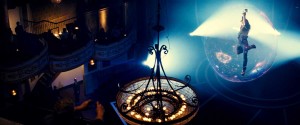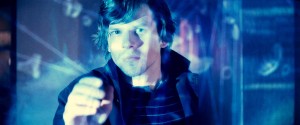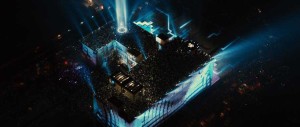
“The challenge here was to tackle a wide range of creative challenges, from major crowd replication in a 9,000-seat stadium during an extended sequence, to high end, holographic design for a sequence in which images were projected onto the side of a building,” said Nicholas Brooks, VFX supervisor for Now You See Me. “[Rodeo] also brought us a virtual CG car chase, photoreal magic props and even enormous bubbles.”
 In a major sequence inside the Las Vegas MGM Grand, which was more than a minute long, Rodeo stitched and morphed three different cable cam plates together to form a 720-degree spinning shot of the stadium. They filled the entire arena with a mix of 2D crowd elements and CG crowd, enhancing the shot with lens flares and the addition of giant video screens using “off the shelf” systems such as Kinect and PS3 cameras for motion capture and 3D scanning. The company also used particle simulation to add millions of Euros falling onto the audience and created and animated a CG “Crusher” (compactor-like prop) that teleports a lead character into a Paris bank vault.
In a major sequence inside the Las Vegas MGM Grand, which was more than a minute long, Rodeo stitched and morphed three different cable cam plates together to form a 720-degree spinning shot of the stadium. They filled the entire arena with a mix of 2D crowd elements and CG crowd, enhancing the shot with lens flares and the addition of giant video screens using “off the shelf” systems such as Kinect and PS3 cameras for motion capture and 3D scanning. The company also used particle simulation to add millions of Euros falling onto the audience and created and animated a CG “Crusher” (compactor-like prop) that teleports a lead character into a Paris bank vault.
“This show was definitely a fun and stimulating project for our CG team,” said Rodeo’s CG supervisor Sébastien Francoeur. “Each sequence had a different challenge. The demands for this film varied from creating realistic, light, flexible bubbles, to making crazy car chases in New York City. I think the fact that we had to manage so many different kinds of shots and not concentrate all of our work on just a few big ones made this film even more exciting for us. For me, personally, the biggest challenge was to create realistic crowd shots through motion capture and scanning.”
 Rodeo’s André Ü Montambeault supervised the sequence called “Five Points,” which presents the third and final magic show presented in the film by the Four Horsemen cast members. The show takes place in an abandoned building covered with graffiti, where the performers present their final illusion in front of a cheering crowd. The magicians present their illusions with a blend of animated projections on the walls, along with a rock-and-roll show style lighting, and classic misdirection, as they mislead the police who are trying to apprehend them.
Rodeo’s André Ü Montambeault supervised the sequence called “Five Points,” which presents the third and final magic show presented in the film by the Four Horsemen cast members. The show takes place in an abandoned building covered with graffiti, where the performers present their final illusion in front of a cheering crowd. The magicians present their illusions with a blend of animated projections on the walls, along with a rock-and-roll show style lighting, and classic misdirection, as they mislead the police who are trying to apprehend them.
“For this sequence, we had to come up with a design that would serve both the show visually and the theater in which the magicians were performing,” Montambeault said. “We created all of the animations that are projected, and integrated them to the plates. We also designed the lighting rig that we see on the rooftop of the Five Points building. The backgrounds were shot with an Alexa camera for all the aerial shots, and in 35mm anamorphic for the rest. A big challenge was to maintain continuity between all the shots and the different cameras. We ended up using all of our available software for this sequence, and even put in place a motion graphics department. We match-moved the live action camera, and then published all the CG scenes of the CG cameras and the layout of the building. The animations that were projected were created in Cinema 4D and XSI. We used the ICE module of XSI extensively to create complex procedural animations, and After-Effects and Nuke were used to pre-comp many layers. This entire sequence was composited on our Flame and Flare systems.”
“This was a very interesting project for us, one that involved a number of complex solutions to creative challenges,” said Isabelle Langlois, Rodeo FX’s head of production. “Every sequence we delivered for this film was so different, and each involved a good amount of communication between director Louis Leterrier, VFX supervisor Nick Brooks, and VFX producer Tom Elder-Groebe. We enjoyed highly productive back and forth conversations with Louis to fine-tune his vision, and Nick Brooks came to Montreal twice to visit with our artists and to work closely in tandem with them.”





